Center Resources Quick Reference
With deep experience and an unbiased perspective, the Center On Executive Compensation serves as an extension of your executive compensation team. With timely information and resources, the Center empowers members to rise to the challenge with their Compensation Committees and a growing number of interested stakeholder groups.
The Center provides expertise and advocacy on the top executive compensation and corporate governance public policy and practice issues facing Chief Human Resource Officers and their teams. Full access to the Center’s advocacy and educational resources is provided through the Center On Executive Compensation premium membership available exclusively to HR Policy Association members.
 | New Approaches to ESG Governance: A CHRO's Guide By Ani Huang An expanding number of investors, regulators, and special interest groups are putting pressure on businesses to infuse company management and stakeholder communications with ESG principles such as DEI and sustainability. Meanwhile, other stakeholders are pressuring businesses to roll back on ESG-related initiatives. This Guide provides approaches to both board and management governance of ESG. Find within tips and best practices on effective management and oversight of ESG concerns, without over-engineering the process. |
Six Approaches to Incentive Targets Amid Economic Volatility and Uncertainty A key responsibility of Compensation Committees is the approval of incentive plan design, especially determining individual awards for the senior-most executives and setting performance objectives for annual and long-term incentive payouts. In times of uncertainty, Committees may seek alternative design approaches to mitigate the risk of setting overly aggressive or overly conservative long-term performance targets. Find within a collection of helpful alternative approaches (with corresponding pros and cons) for structuring long-term incentive arrangements in a volatile environment. | 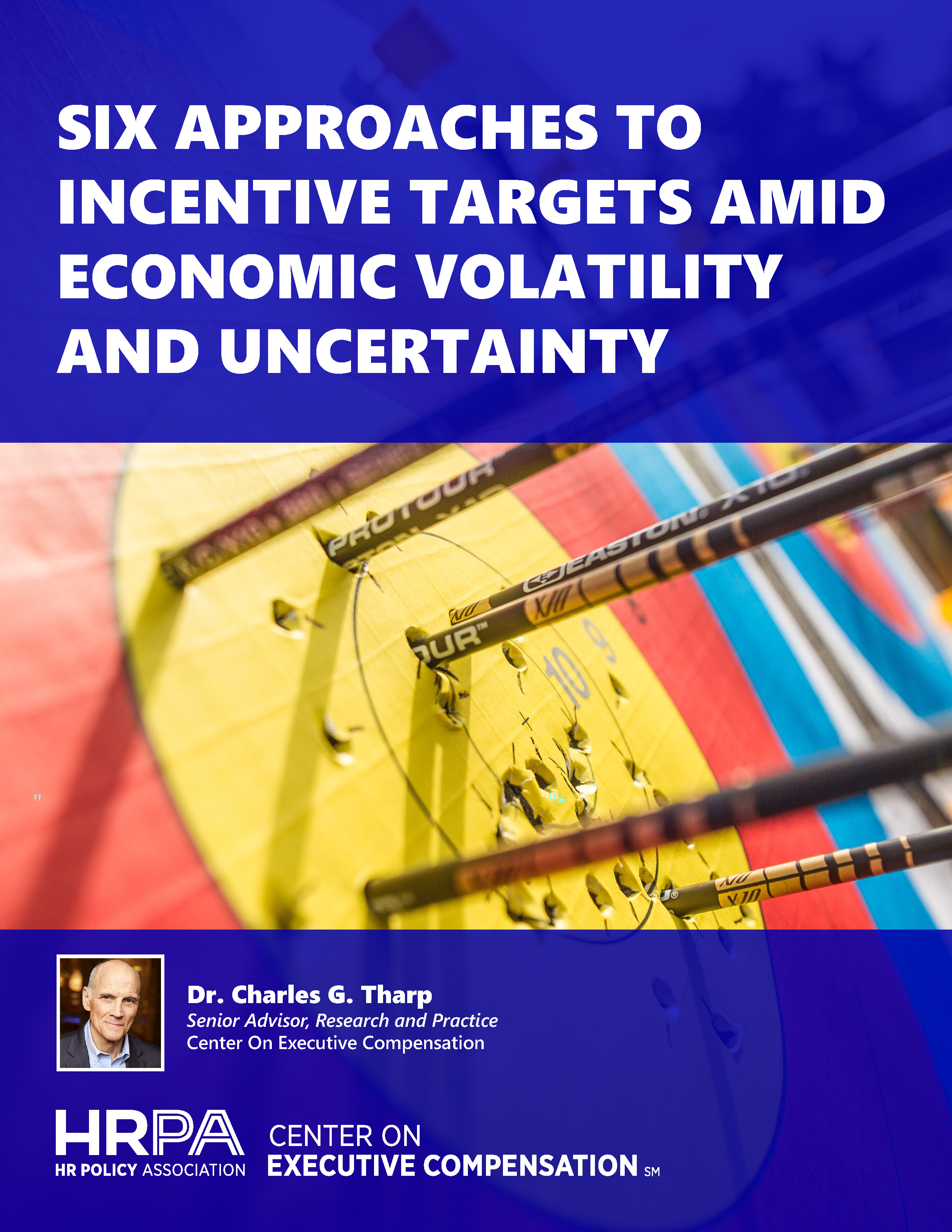 |
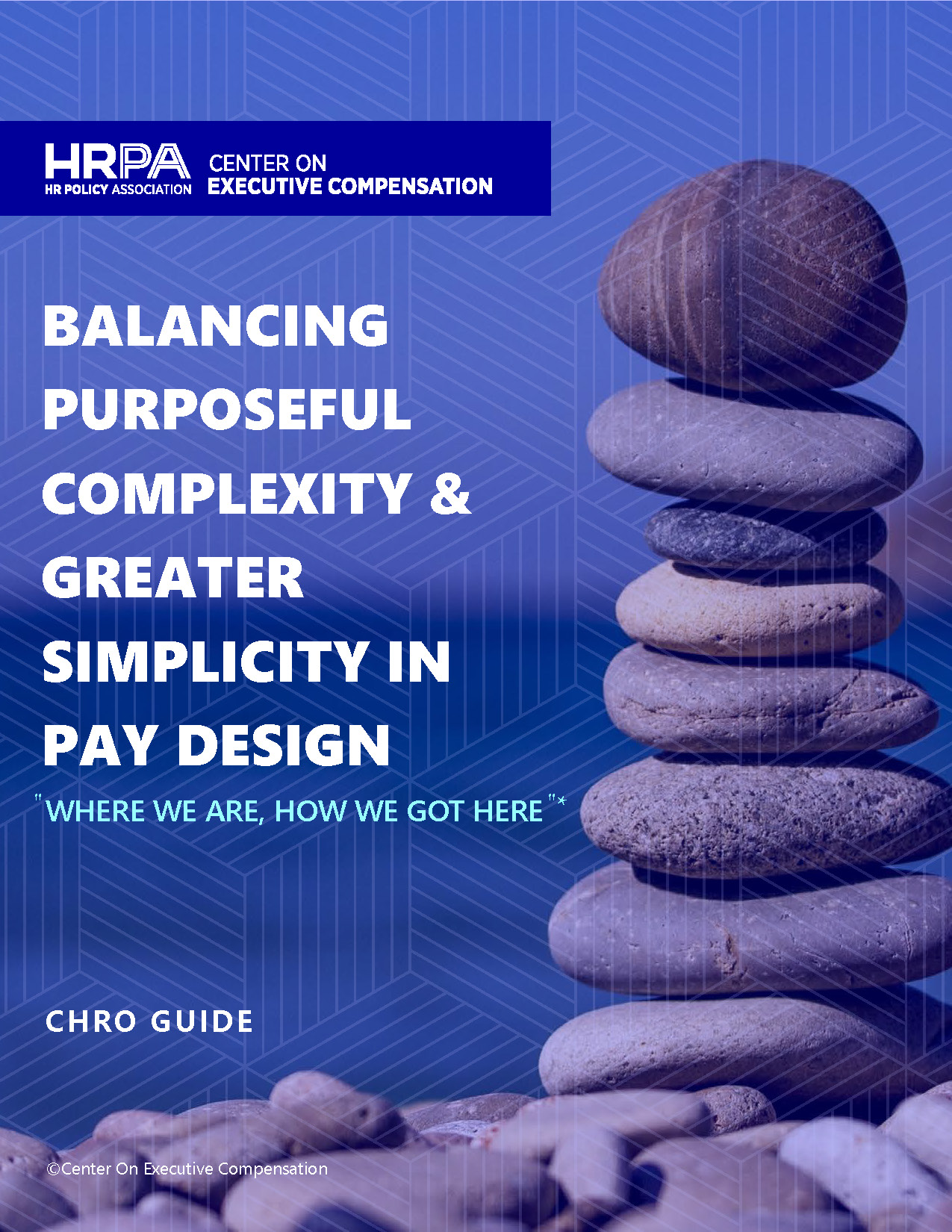 | Balancing Purposeful Complexity & Greater Simplicity in Pay Design Over the past few decades, there has been an explosion of criticism of CEO compensation. Efforts to lower executive pay or strengthen the link between pay and performance have only increased complexity without actually addressing the issue. The time may be ripe for new thinking and experimentation in the design of executive incentives. |
Selecting an Independent Compensation Consultant: A CHRO Guide By Ani Huang and Richard R. Floersch Each company is unique in its approach to the evaluation and selection of an independent compensation consultant. A good consultant will ensure that the Compensation Committee’s decisions are fair, reasonable, and support the company's mission. It is crucial that CHROs arm their Committees with clear direction to ensure an efficient process, smooth transitions, and a favorable outcome. Useful to new and experienced CHROs alike, this practical Guide is a collection of the tools, tips, and insights necessary to successfully navigate the review and selection process. |  |
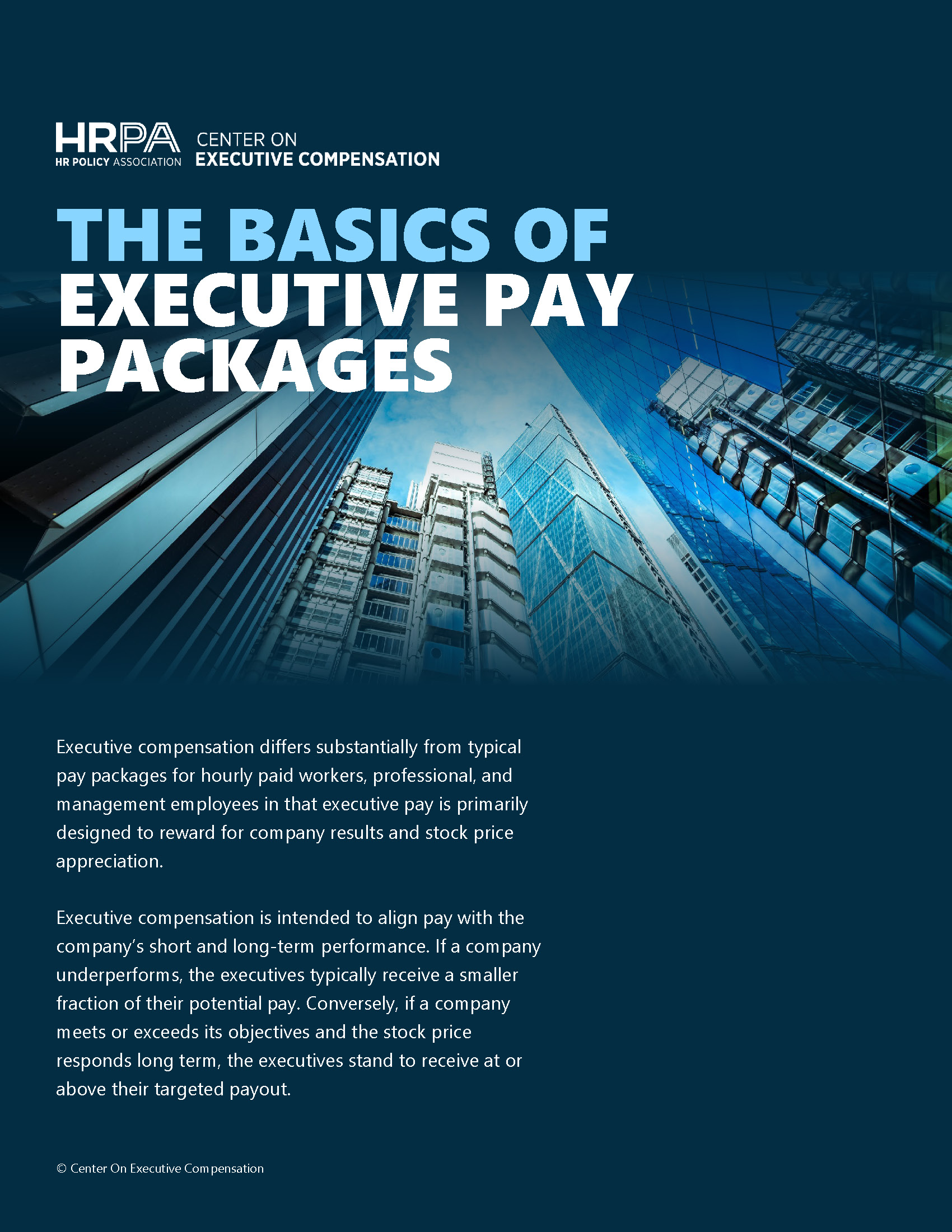 | The Basics of Executive Pay Packages By Ani Huang Executive compensation differs substantially from typical pay packages for hourly paid workers, professional, and management employees in that executive pay is primarily designed to reward for company results and stock price appreciation. Executive compensation is intended to align pay with the company’s short and long-term performance. If a company underperforms, the executives typically receive a smaller fraction of their potential pay. Conversely, if a company meets or exceeds its objectives and the stock price responds long term, the executives stand to receive at or above their targeted payout. |
The SEC’s Insider Trading and 10b5-1 Plan Rule: A Compliance Guide By Ani Huang In light of the SEC’s final rules on 10b5-1 Plans, this Guide explains the complex technical and disclosure requirements as well as the potential external ramifications of such disclosures. Find within a summary of each of the four components of the regulation, and understand the potential implications for the CHRO, Compensation Committee, and Corporate Secretary, as well as recommended next steps to ensure compliance. | 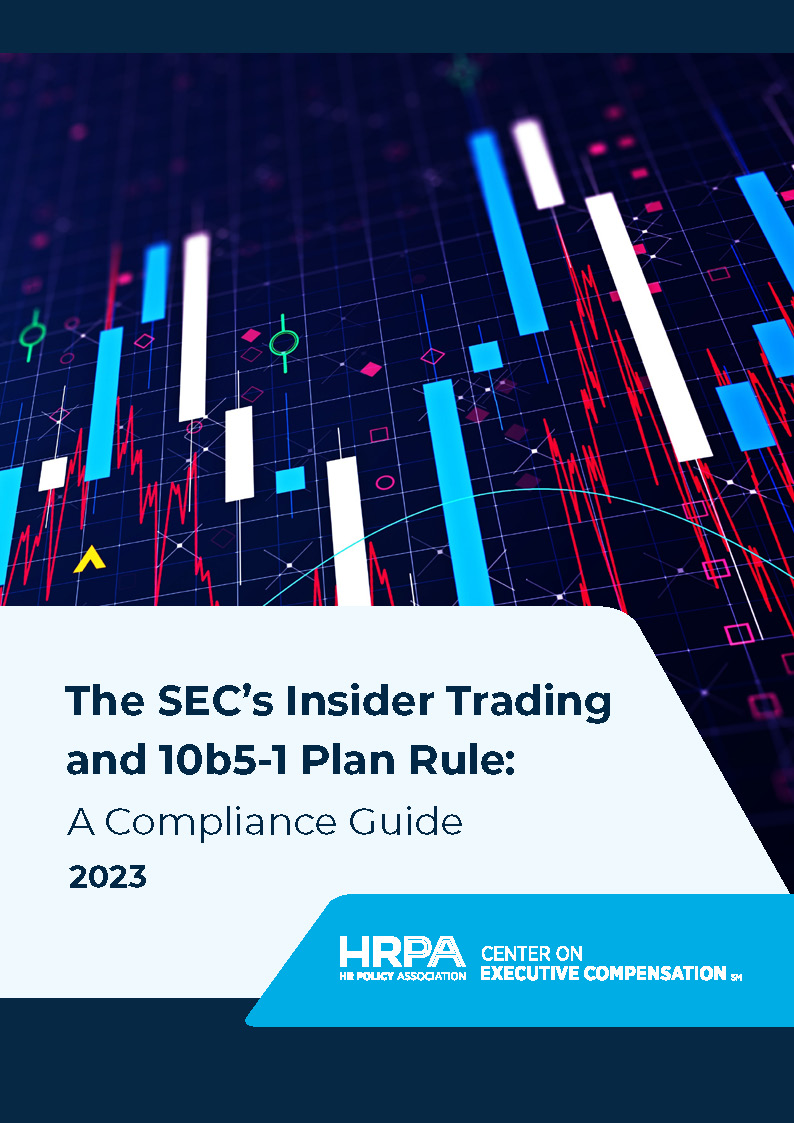 |
 | The Evolving Role of the Head of Total Rewards Over the past decade, the Head of Total Rewards has transformed from expert technician to trusted and influential advisor in an increasingly complex role. This study examines the requirements of the role, and how shifts in the workforce and changes in employee expectations continue to influence total rewards programs and the leaders responsible for designing them. The report captures key themes surrounding the breadth of experience, key areas of focus, critical relationships, and success factors of the total rewards leader. |
The SEC’s Pay for Performance Rule: A Compliance Guide By Ani Huang So much has changed in the years since the SEC’s “Pay Versus Performance” disclosure rule was originally proposed that the final rule seems to be “a day late and a dollar short.” Although the mandated disclosure may be misleading (as it may contradict other pay for performance disclosures already in the proxy) and meaningless (because it is an assortment of unrelated items grouped together into a table), certain companies will be required to include it in their proxy going forward. This Compliance Guide will help you negotiate not only the technical aspects of the rule but the potential external ramifications of the disclosure. | 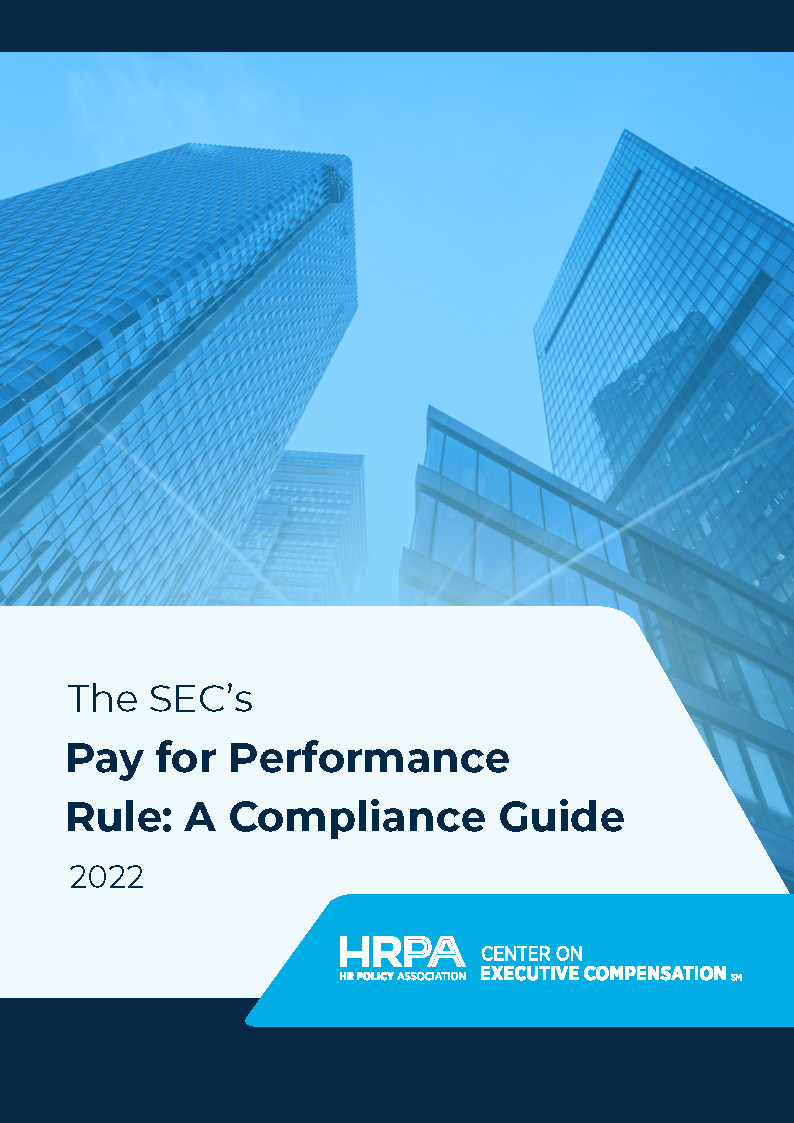 |
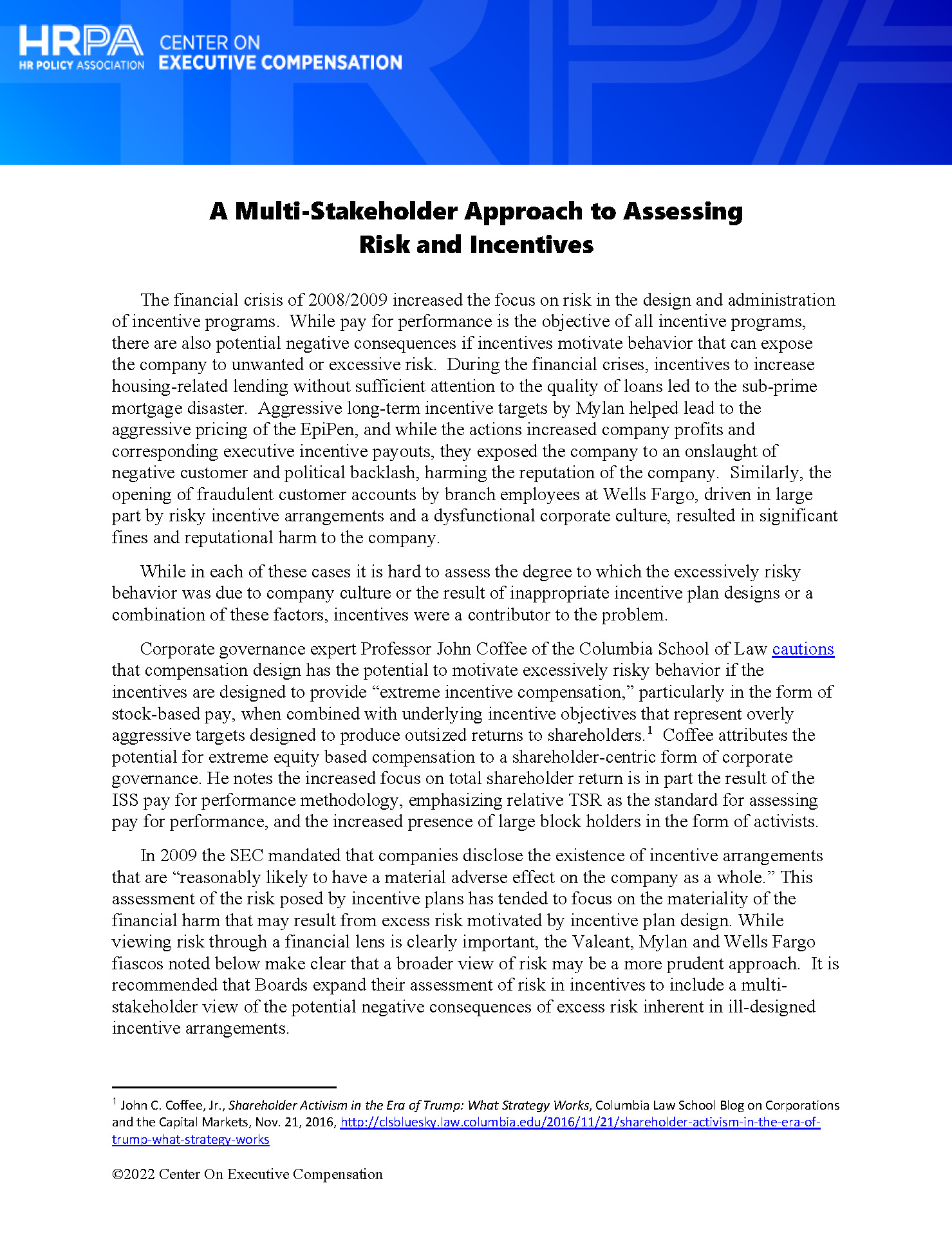 | A Multi-Stakeholder Approach to Assessing Risk and Incentives While pay for performance is the objective of all incentive programs, there are also potential negative consequences if incentives motivate behavior that can expose the company to unwanted or excessive risk. While viewing risk through a financial lens is important, a broader view may be a better approach. Boards should expand their assessment of risk in incentives to include a multi-stakeholder view of the potential negative consequences of excess risk inherent in ill-designed incentive arrangements. |
Compensation Committee Checklist for Assessing Incentives and Risk As Compensation Committees consider and finalize executive compensation arrangements, they will seek to confirm that the company’s incentive programs are appropriately structured and discourage executives from taking “excessive risk.” After the 2009 SEC regulations requiring analysis of risk for compensation programs aimed at employees below the executive level, many Committees choose to voluntarily disclose how their compensation programs address the subject of risk. This checklist will help guide Compensation Committees through this process. | 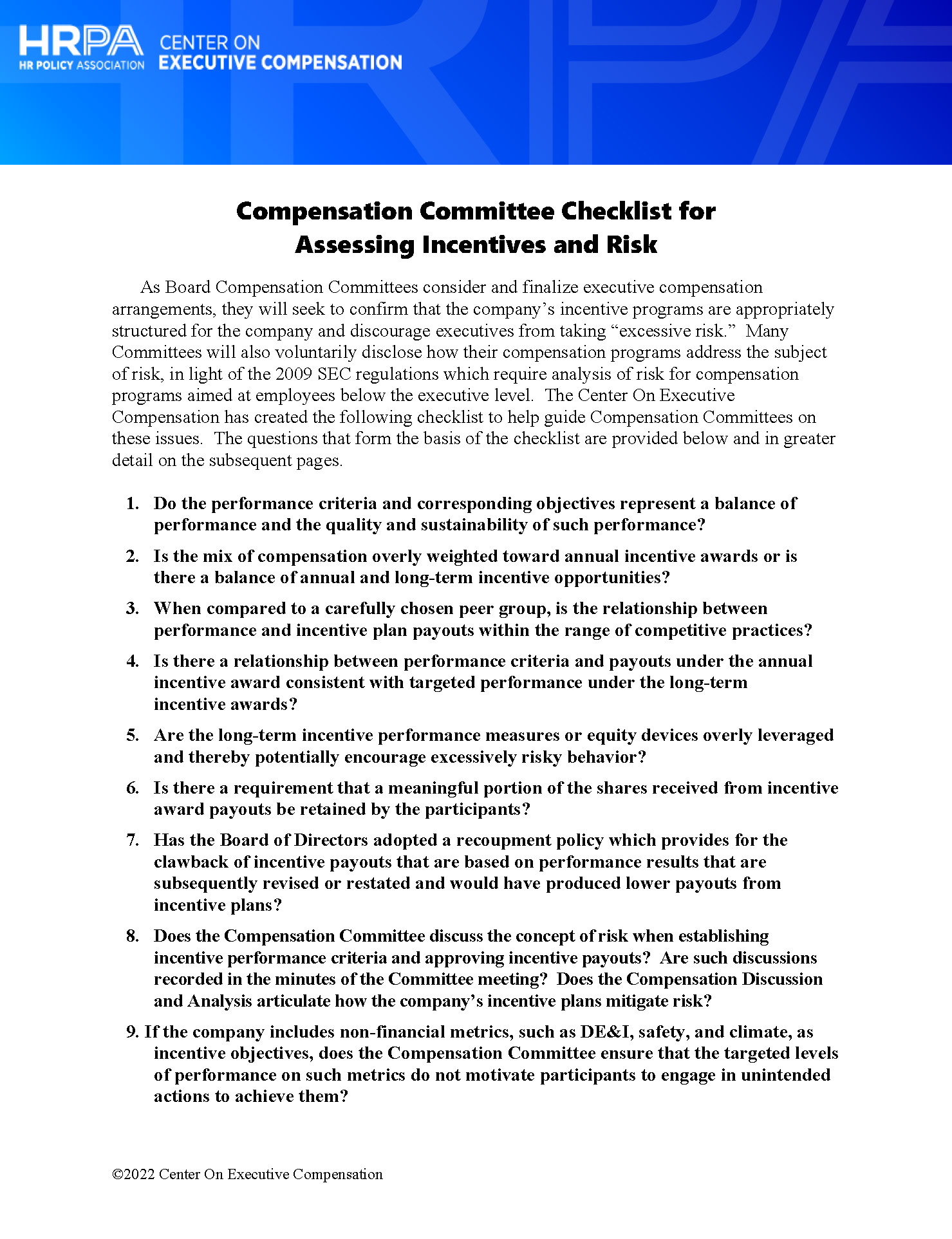 |
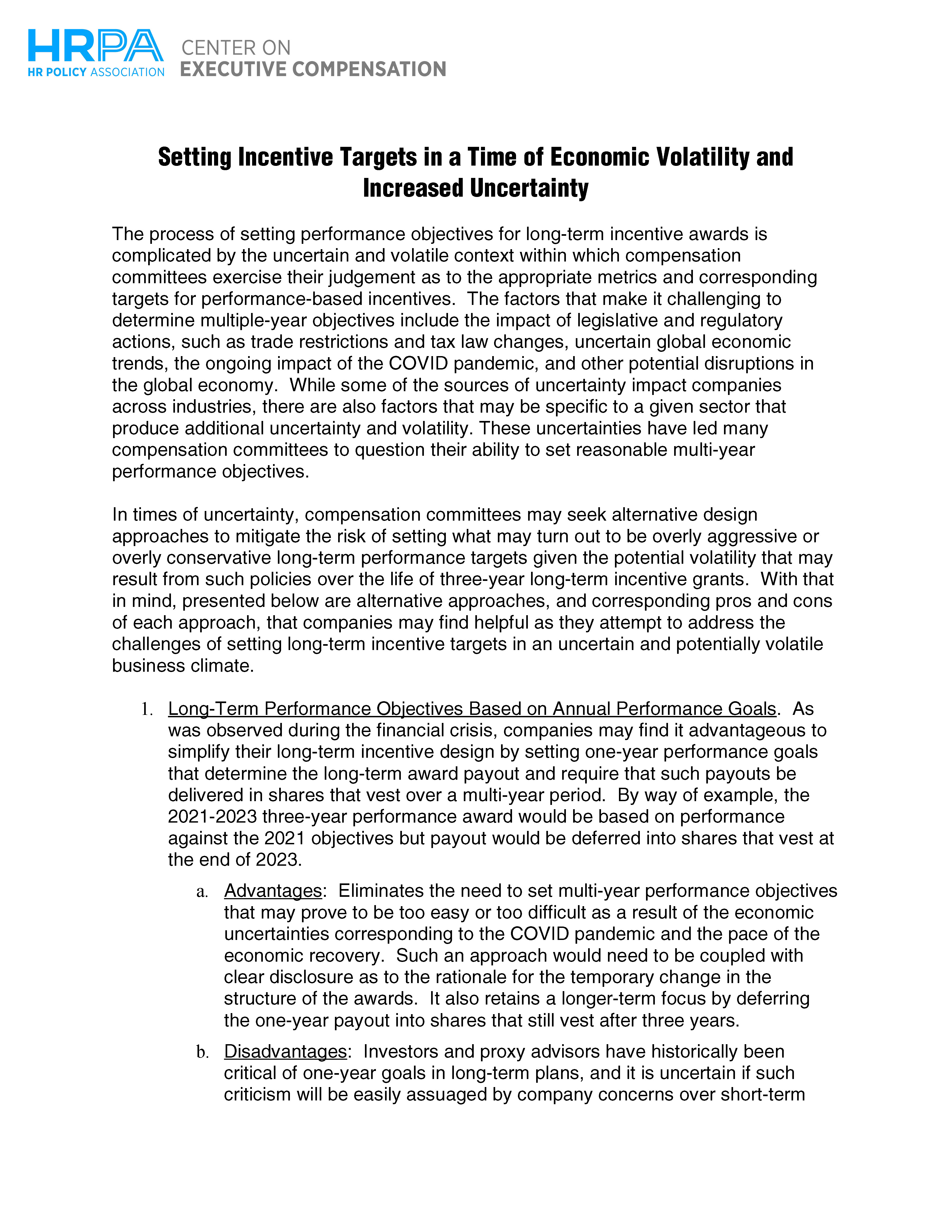 | Setting Incentive Targets in a Time of Economic Volatility and Increased Uncertainty The process of setting performance objectives for long-term incentive awards is complicated by the uncertain and volatile context within which Compensation Committees exercise their judgement as to the appropriate metrics and corresponding targets for performance-based incentives. Certain factors make it challenging to determine multiple-year objectives, including the impact of legislative and regulatory actions, uncertain global economic trends, and other potential disruptions in the global economy. While some sources of uncertainty impact companies across industries, there are also factors that impact specific sectors that result in additional uncertainty and volatility. These uncertainties have led many Compensation Committees to question their ability to set reasonable multi-year performance objectives. |
The Use of Adjustments to GAAP Metrics in Executive Incentives With the elimination of the performance-based exception to deductible compensation limits under IRC Section 162(m), companies will have the opportunity to simplify their incentive structures. No longer facing requirements for “pre-establishing” goals and setting targets within a strict timeline, companies will have greater flexibility and freedom to determine the performance metrics and targets used in their incentive plans. This flexibility comes at a time when investors and other stakeholders are paying increasing attention to how companies select metrics and set targets in their executive incentive plans. One of the most challenging issues in this debate involves the appropriateness of using metrics that incorporate “adjustments” to publicly reported measures that conform to Generally Accepted Accounting Principles (or, GAAP). In 2017, 95% of companies in the S&P 500 disclosed at least one non-GAAP metric, and the use of incentive plan metrics that incorporate adjustments to GAAP is commonplace. | 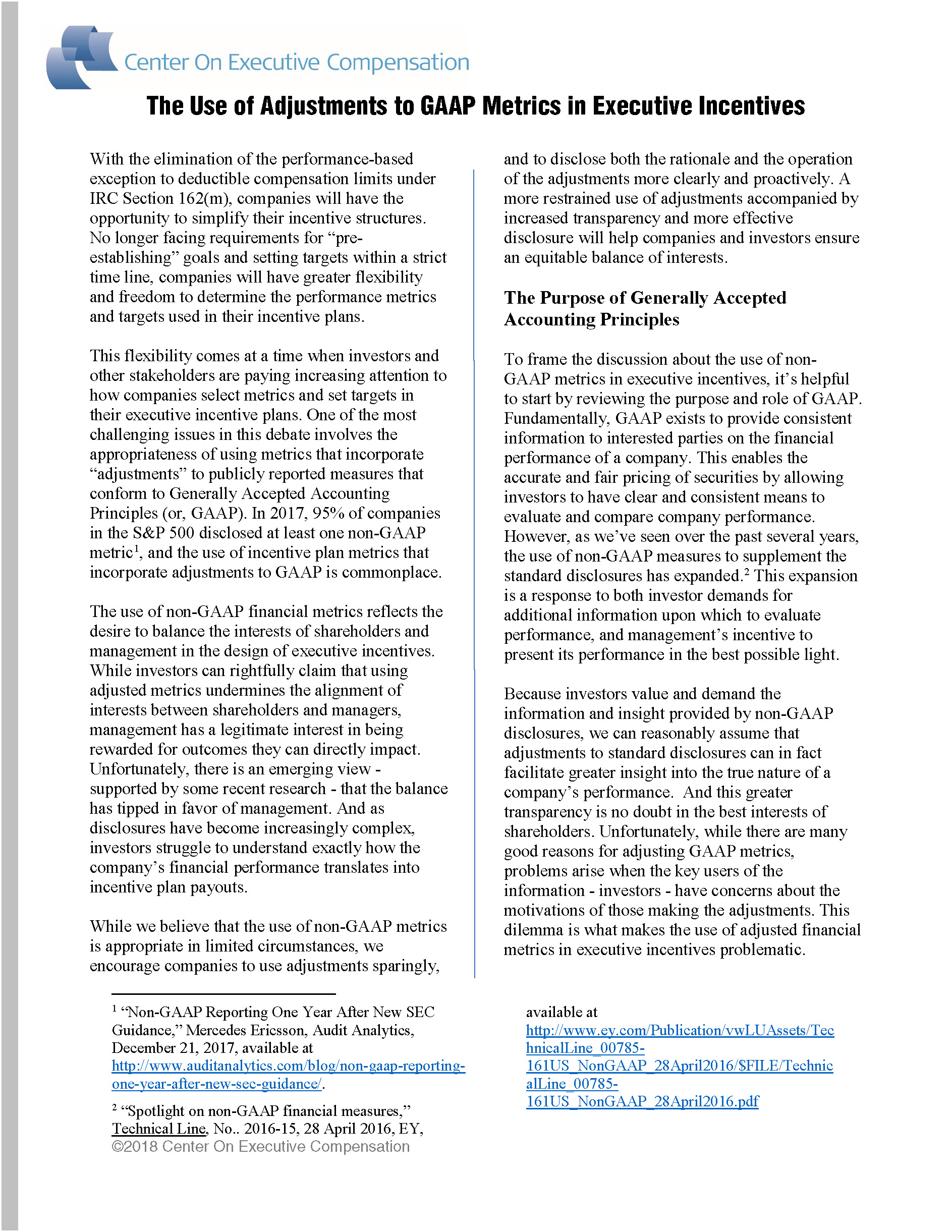 |
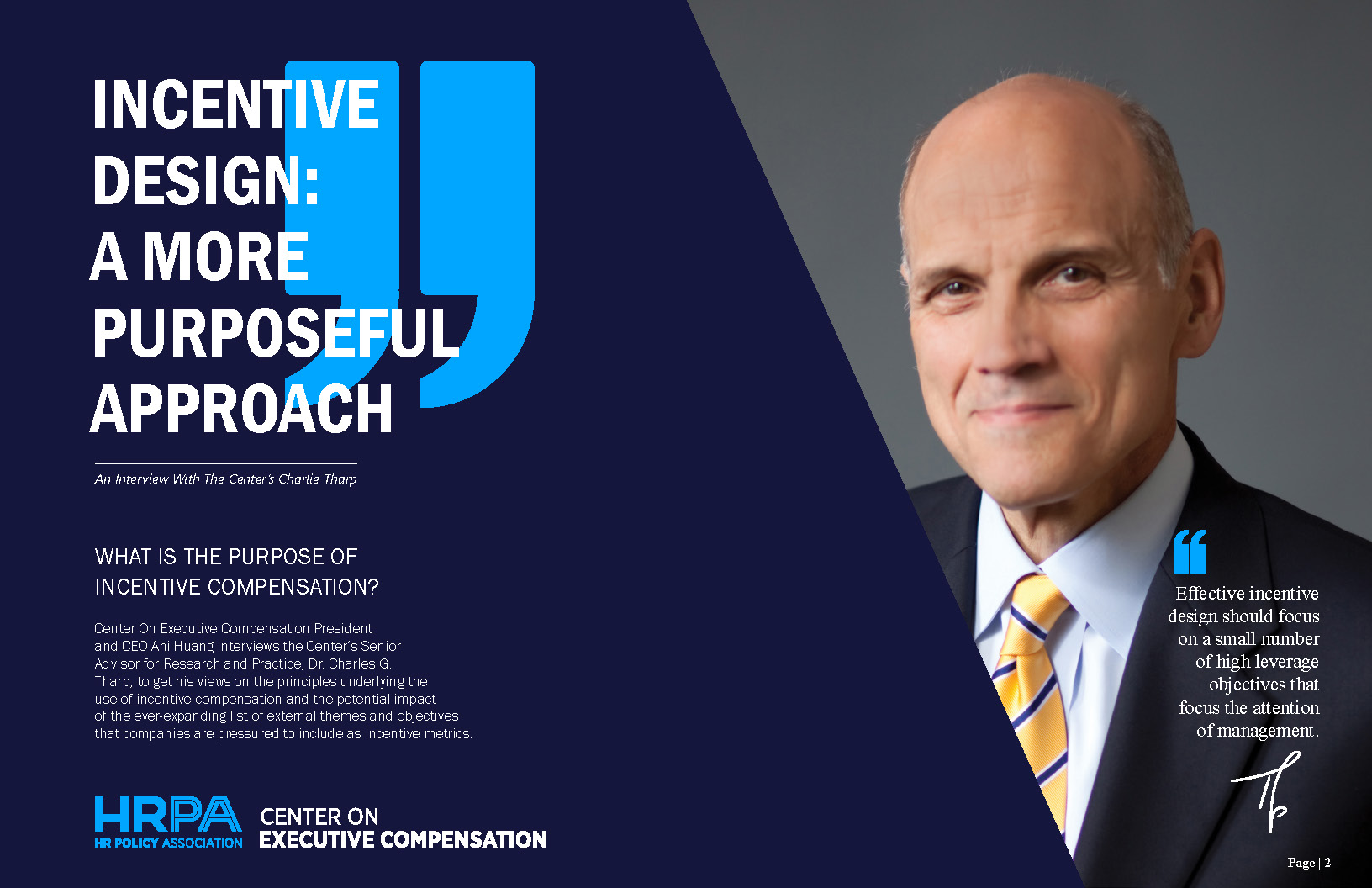 | Incentive Design: A More Purposeful Approach, an Interview with Dr. Charlie Tharp By Ani Huang Amid an increased focus on stakeholder capitalism, companies are balancing the needs of a multitude of stakeholders when it comes to designing executive pay. The introduction of Say-on-Pay, combined with increased pressure from investors and proxy advisory firms has led to a number of changes. This continued pressure for expansion of performance objectives for senior management and metrics upon which executive incentive arrangements are based has prompted the Center to explore the potential implications of this trend on the purpose and effectiveness of incentives. |
Sample Executive Compensation Consultant RFP Overview By Ani Huang With the compensation consultant independence criteria required by Dodd-Frank, and a growing overall focus for Boards on related governance and disclosure requirements, the need for guidance in the selection of new consultants has become more important than ever. Although the types of questions and scope of services differ based on individual company needs, the main components of compensation consultant requests for proposal (RFPs) are strikingly similar. This sample RFP errs on the side of more rather than fewer questions, allowing companies beginning this process to modify the template to suit their needs. | 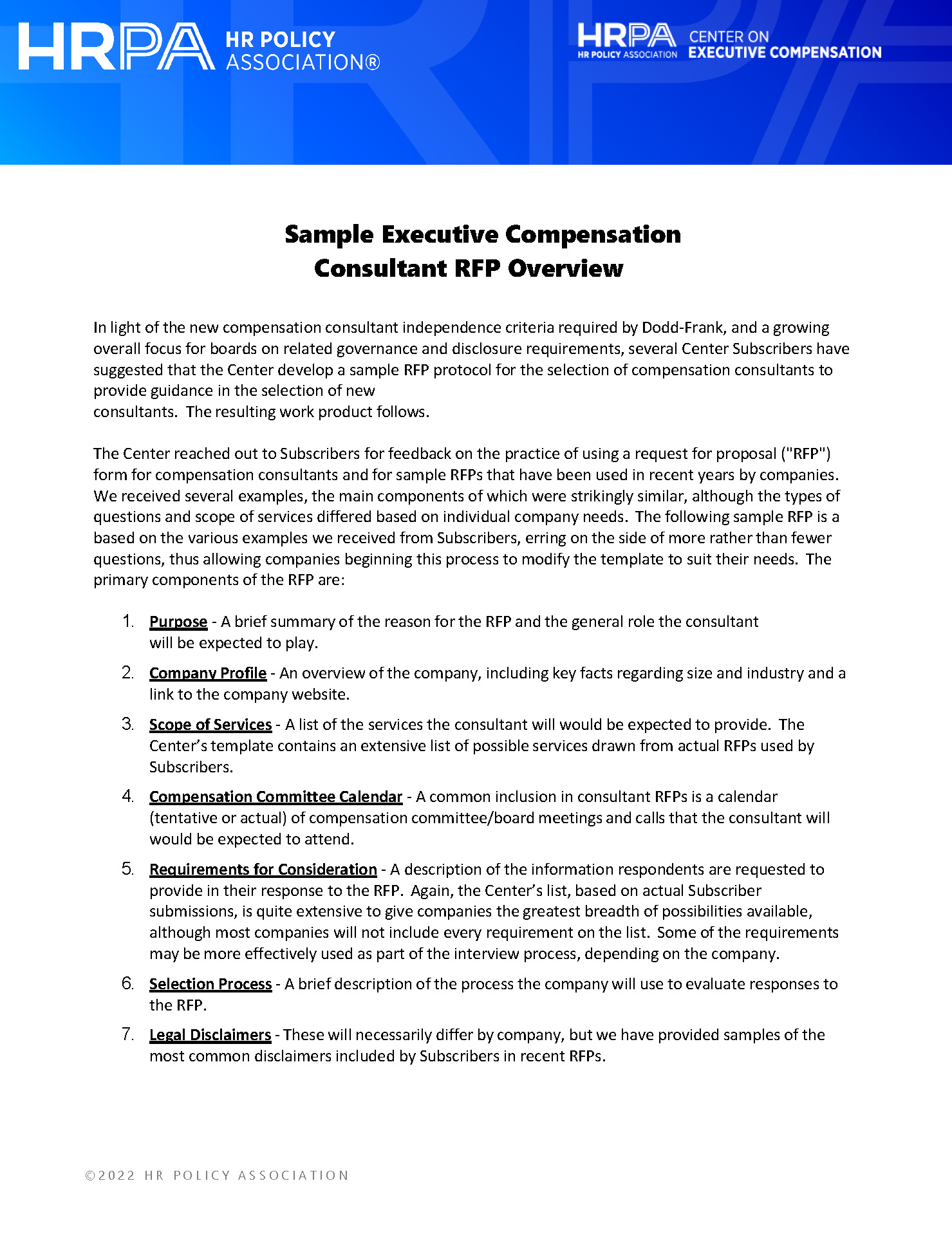 |
 | Why CHROs Should Challenge Conventional Wisdom When Selecting Incentive Plan Measures Faced with increased leverage from proxy advisory firms, many boards are approving incentive plans that conform to proxy firm guidance instead of tailoring their plans to meet the unique needs of their firms. By challenging conventional wisdom with fact-based analysis, CHROs can change the dialogue around pay and provide their compensation committees the foundation to challenge the “one size fits all” mentality of the Say on Pay era. |
What you Pay For is More Important than How You Pay Using your company’s Measures strategy as a starting point, re-imagining incentive plan design is a process of discovering the financial and non-financial drivers that are most likely to result in sustained shareholder value over time. There are many types of financial measures used by a wide variety of stakeholders – investors, accountants, regulators, and executives to name a few. When it comes to incentive design, the most popular measures used in short term plans are revenue, operating income and earnings per share; while relative TSR, EPS and capital return measures are most common in long term performance plans. |  |
 | Pay Alone Isn’t Enough: The Role of Executive Compensation in an Integrated Talent Strategy We continue this series by taking a more holistic view – recognizing that a well designed pay program is important to a company’s success, but it is not enough. It is only one component of a larger, comprehensive talent strategy. To truly turn the company’s talent into a source of competitive advantage, CHROs need to develop people, pay, organization and culture strategies. |
The Advantages of a Renewed Focus on Governance Here we address the essential role that corporate governance plays in the process, especially the role of the compensation committee in determining the level and form of executive compensation and corresponding incentive performance metrics. Companies seeking to re-orient their incentive plans by moving beyond TSR need to ensure that the compensation committee fully understands the company’s drivers of long term value creation, how pay is linked to business and talent strategies while ensuring that appropriate governance processes are followed. This is especially the case now that large investors increasingly want to hear from directors on these issues and proxy advisory firm recommendations can have a big influence on both say on pay outcomes and on the reelection of directors. |  |
 | Establishing Performance Targets After years of Say on Pay votes resulting in overwhelmingly positive support for management, it would be understandable to conclude that the debate over executive compensation has been settled. The most questionable pay practices have largely disappeared, shareholder engagement with management is at an all time high, and pay packages are more closely linked with performance than ever before. However, as we have discussed in the first two parts of this series, the focus on executive pay has now shifted to questioning whether companies are basing the assessment of pay for performance on the metrics most aligned with their business strategy. While total shareholder return (TSR) has become the predominant metric for long-term performance plans, investors are questioning whether it is the right metric for focusing management’s attention on long-term value creation. |
Diversity and Inclusion Metrics in Incentive Design Amid the turmoil created by recession, political and social unrest, and a global pandemic, executive compensation practices in the U.S. have remained relatively stable over the past decade. Pay for performance is still the predominant approach to compensation design in public companies, equity remains the primary vehicle for creating alignment with shareholders and pay levels for executives continue to rise. In this installment of our Executive Compensation Reimagined series, we’ll explore how companies who have decided to incorporate D&I metrics into executive pay can apply established principles used in selecting financial metrics to address this important design challenge. We’ll discuss the key steps in this process. |  |
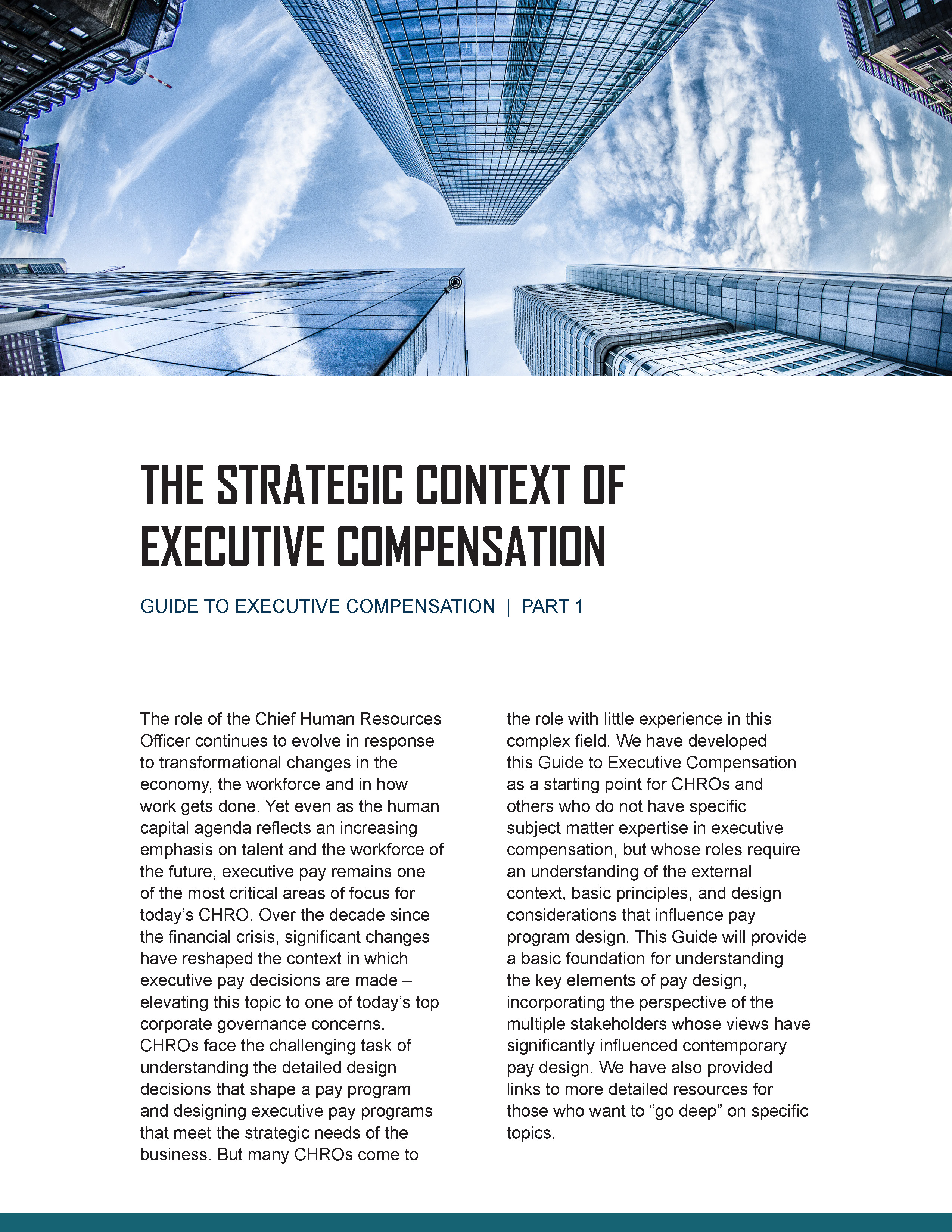 | A CHRO's Guide to Executive Compensation The role of the CHRO continues to evolve in response to transformational changes in the economy, the workforce, and in how work gets done. Yet even as the human capital agenda reflects an increasing emphasis on talent and the workforce of the future, executive pay remains one of the most critical areas of focus for today’s CHRO. In the time since the 2008 financial crisis, significant changes have reshaped the context in which executive pay decisions are made – elevating this topic to one of today’s top corporate governance concerns. CHROs face the challenging task of understanding the detailed design decisions that shape a pay program and designing executive pay programs that meet the strategic needs of the business. But many CHROs come to the role with little experience in this complex field. This Guide is a starting point for CHROs and others who do not have specific subject matter expertise in executive compensation, but whose roles require an understanding of the external context, basic principles, and design considerations that influence pay program design. |
The CHRO’s Guide to the Expanded Role of the Compensation Committee By Ani Huang and Richard R. Floersch Useful to new and experienced CHROs alike, this Guide is a collection of insights and tips on expanding the charter of the Compensation Committee. Based on interviews with Compensation Chairs, CHROs, and Compensation Consultants, the Guide represents the experiences, learnings, and advice on managing the charter, calendar, agenda, external resources, and education of the Committee. This Guide contains a summary of the primary changes to the Committee’s makeup, agenda, and charter, new expectations for directors, and the benefits and challenges associated with an expanded Committee. Learn the prevailing practices, plus some trend-forward or “best practices” that may not have hit the mainstream yet. | 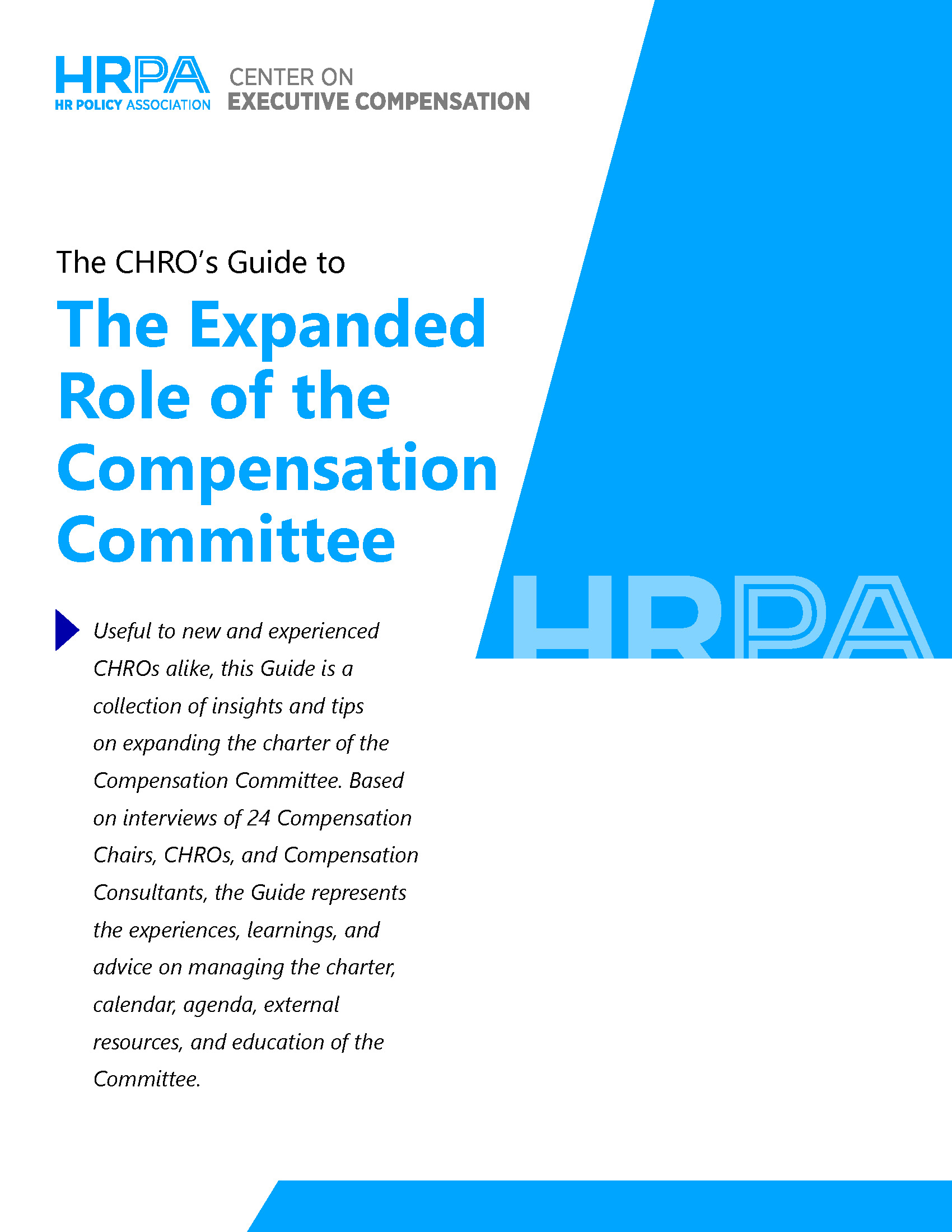 |
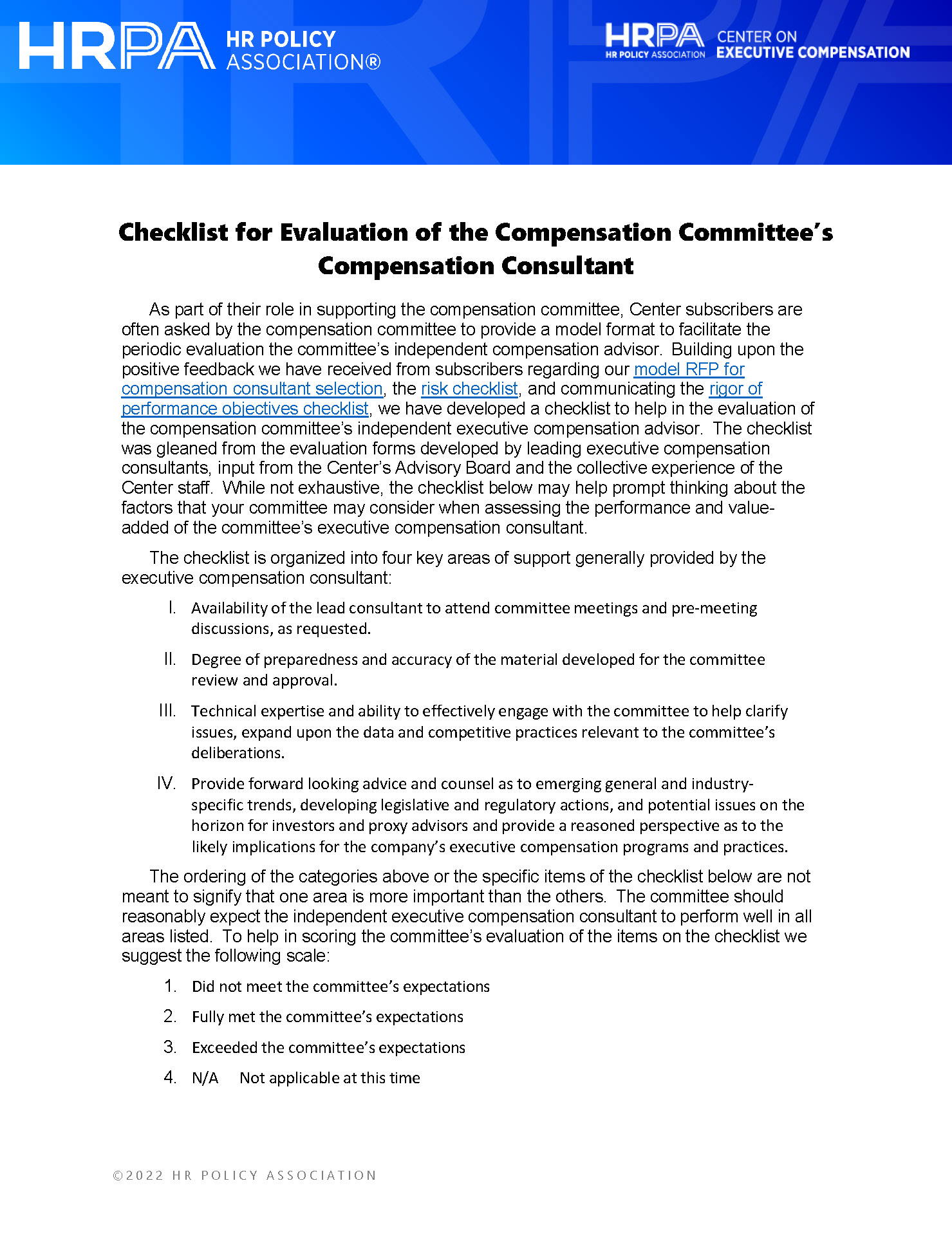 | Checklist for Evaluation of the Compensation Committee’s Compensation Consultant By Ani Huang As part of their role in supporting the Compensation Committee, CHROs and their teams are often asked to provide a model format to facilitate the periodic evaluation the Committee’s independent compensation advisor. This comprehensive checklist was gleaned from evaluation forms developed by leading executive compensation consultants, input from the Center’s Advisory Board and the collective experience of the Center staff. While not exhaustive, the checklist will help prompt thinking about the factors that your Committee should consider when assessing the performance and value-add of the Committee’s executive compensation consultant. CHROs face the challenging task of understanding the detailed design decisions that shape a pay program and designing executive pay programs that meet the strategic needs of the business. But many CHROs come to the role with little experience in this complex field. This Guide is a starting point for CHROs and others who do not have specific subject matter expertise in executive compensation, but whose roles require an understanding of the external context, basic principles, and design considerations that influence pay program design. |
ESG and the Role of the Chief Human Resources Officer By Ani Huang Investors are considering environmental, social, and governance (ESG) disclosures as a potential information source for extracting a competitive advantage, especially over the long term. Companies are integrating ESG as a remunerative facet of their business models—and as a risk management strategy. Employees, potential hires, customers, and consumers are reacting positively to companies’ ESG efforts. Among many stakeholders, financial performance is no longer considered a tradeoff to ESG initiatives. | 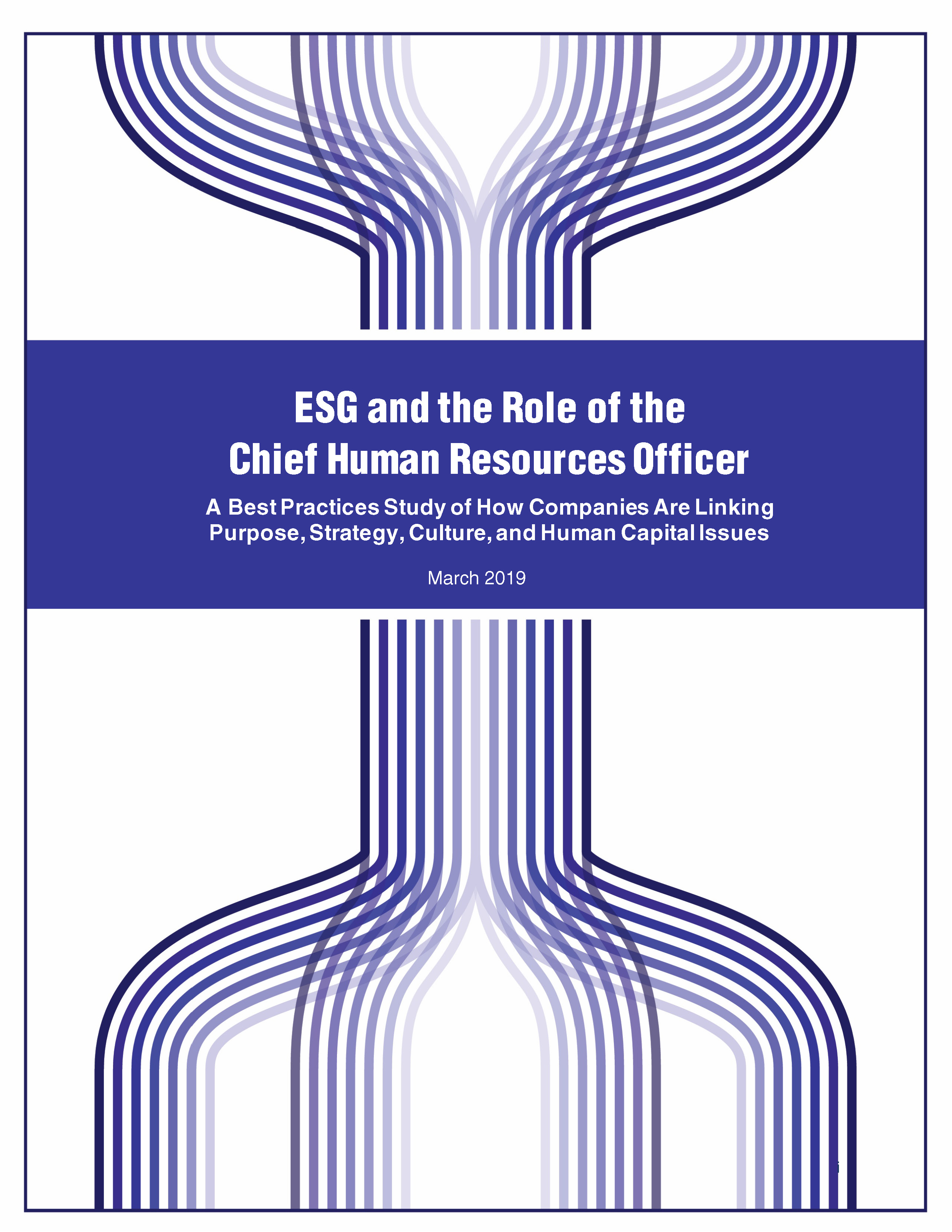 |
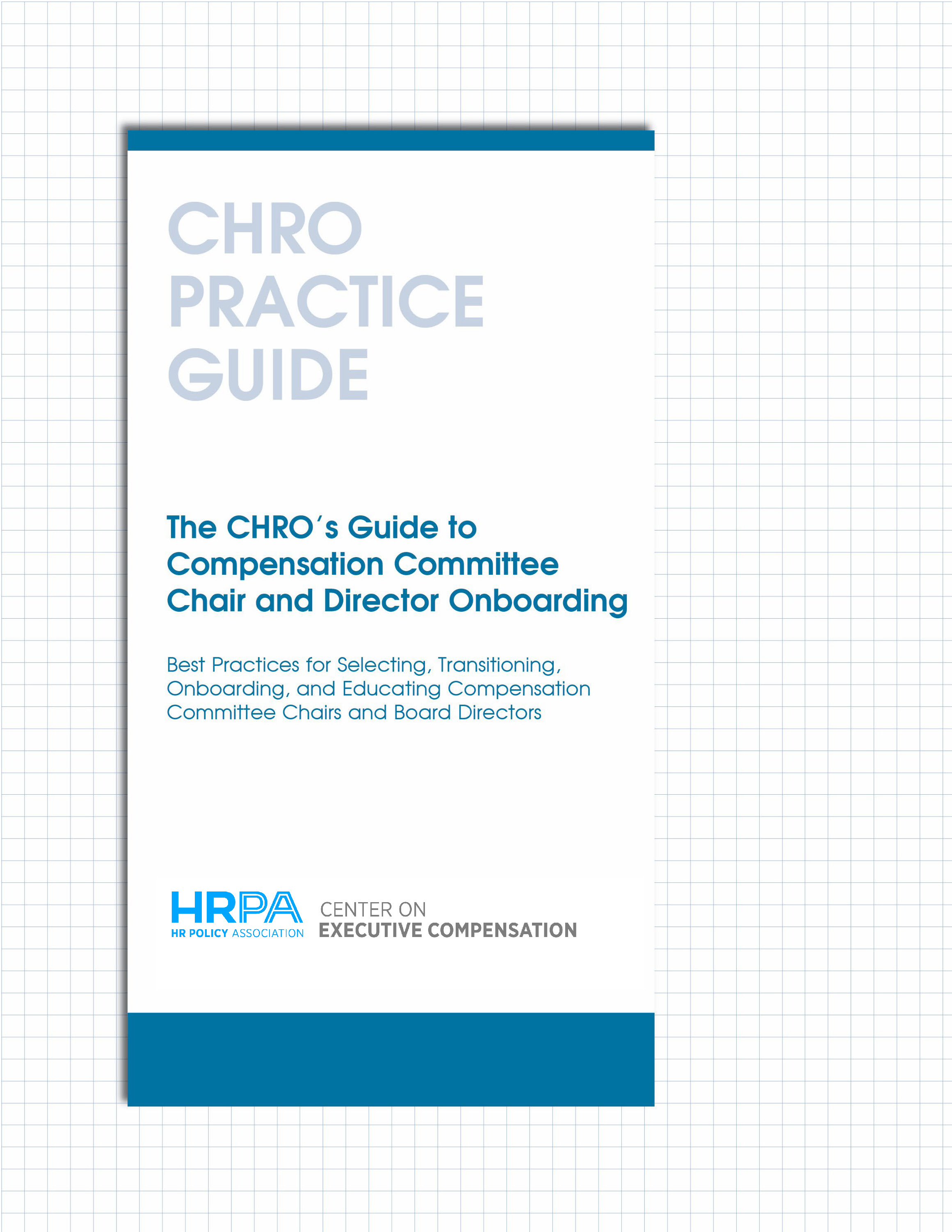 | The CHRO's Guide to Compensation Committee Chair and Director Onboarding By Ani Huang As the Compensation Committee Chair role has become increasingly complex and public-facing, the selection of an incoming Chair as well as onboarding and ongoing education for both the Chair and other Board Directors are critically important. A well planned and executed onboarding program will increase the odds that a new Chair or Director will be able to make meaningful contributions to the organization sooner rather than later. Although historically this process has been primarily the responsibility of the Lead Director and the General Counsel or Corporate Secretary, CHROs are finding that their unique knowledge, skills, and expertise with regard to talent, compensation, and company culture are highly prized by new Directors. Given the increased focus on Board governance by investors, proxy advisors and other stakeholders, many CHROs have found themselves intimately involved in the Director onboarding and education process. |
Guide to Navigating the Proxy Advisory Firm “Against” Recommendation This Guide provides a framework of best practices and considerations for handling the myriad issues presented by proxy season and proxy advisory firm recommendations. During proxy season, CHROs and their teams face many challenges, including the impact of the Say on Pay vote recommendations of the two largest proxy advisory firms, Institutional Shareholder Services (ISS) and Glass Lewis & Co. Not just for companies that have received an “Against” recommendation, this Guide provides a comprehensive list of considerations which, if followed, can significantly benefit all companies navigating the influence of proxy advisory firms. | 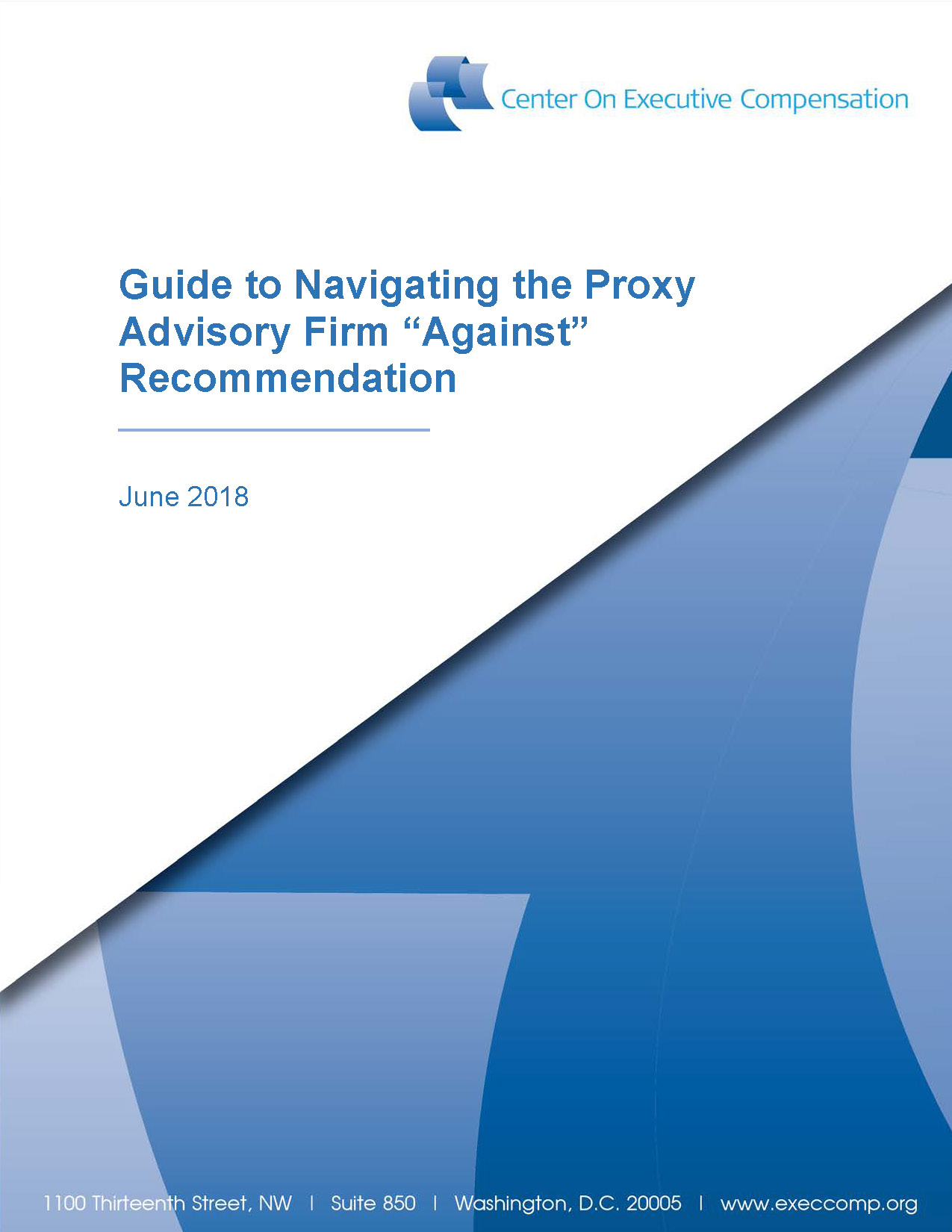 |
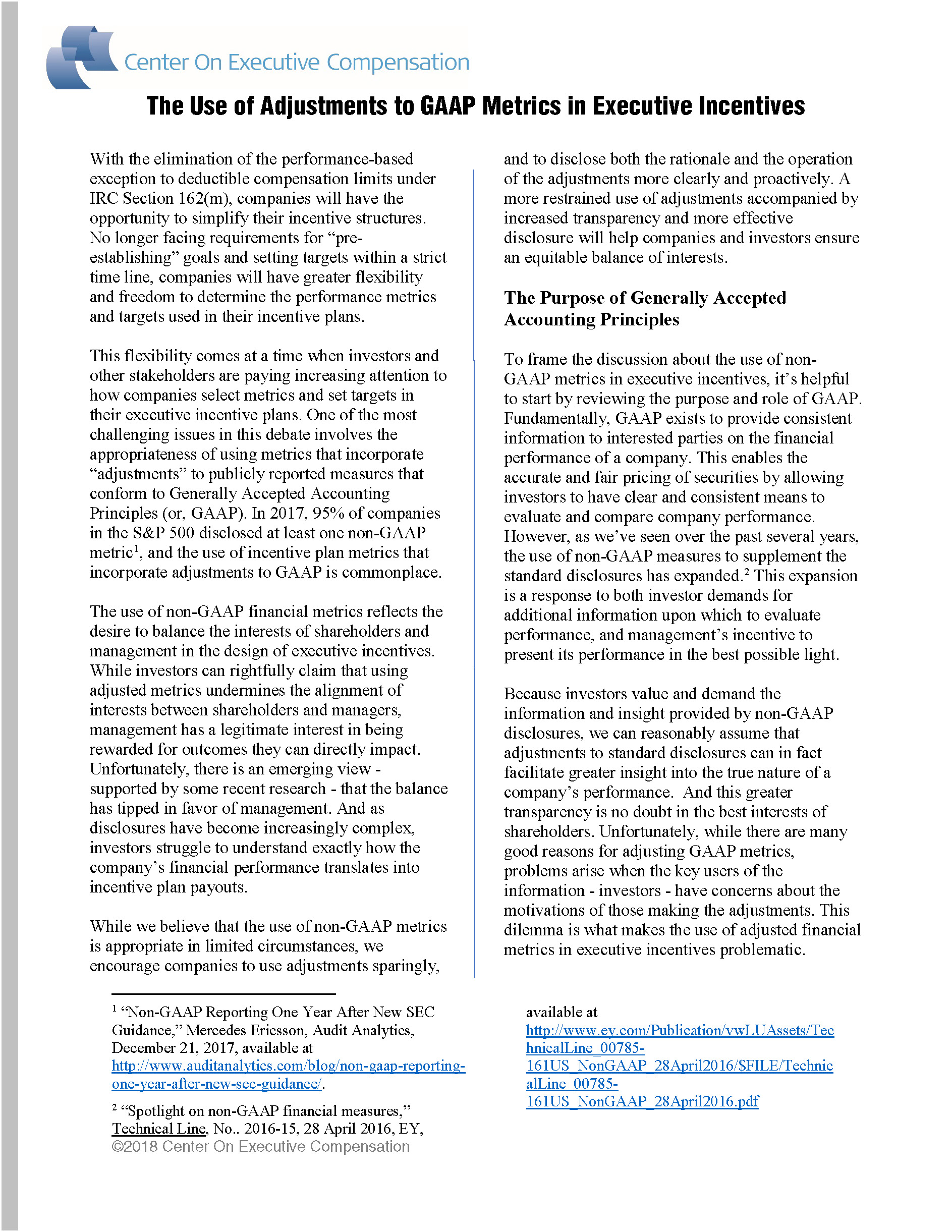 | The Use of Adjustments to GAAP Metrics in Executive Incentives The selection of performance metrics is one of the most important aspects of the executive incentive design process. Companies translate business strategy into incentive plans via the metrics they choose to reward and the target levels of performance they establish. Creating a clear connection between business strategy, performance outcomes, and management rewards is a key objective of executive pay programs. The most effective incentive plans create an effective inducement to drive differentially better results, and do so in a manner that is perceived as fair by its participants. Learn more about the key elements of incentive plans and the use of adjustments to GAAP metrics in addressing the equitable balance between the interests of management and those of investors in fair and reasonable rewards programs. |